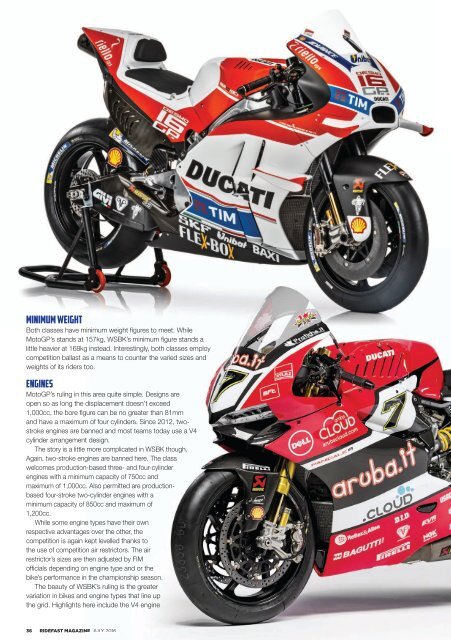You also want an ePaper? Increase the reach of your titles
YUMPU automatically turns print PDFs into web optimized ePapers that Google loves.
Minimum weight<br />
Both classes have minimum weight figures to meet. While<br />
MotoGP’s stands at 157kg, WSBK’s minimum figure stands a<br />
little heavier at 168kg instead. Interestingly, both classes employ<br />
competition ballast as a means to counter the varied sizes and<br />
weights of its riders too.<br />
Engines<br />
MotoGP’s ruling in this area quite simple. Designs are<br />
open so as long the displacement doesn’t exceed<br />
1,000cc, the bore figure can be no greater than 81mm<br />
and have a maximum of four cylinders. Since 2012, twostroke<br />
engines are banned and most teams today use a V4<br />
cylinder arrangement design.<br />
The story is a little more complicated in WSBK though.<br />
Again, two-stroke engines are banned here. The class<br />
welcomes production-based three- and four-cylinder<br />
engines with a minimum capacity of 750cc and<br />
maximum of 1,000cc. Also permitted are productionbased<br />
four-stroke two-cylinder engines with a<br />
minimum capacity of 850cc and maximum of<br />
1,200cc.<br />
While some engine types have their own<br />
respective advantages over the other, the<br />
competition is again kept levelled thanks to<br />
the use of competition air restrictors. The air<br />
restrictor’s sizes are then adjusted by FIM<br />
officials depending on engine type and or the<br />
bike’s performance in the championship season.<br />
The beauty of WSBK’s ruling is the greater<br />
variation in bikes and engine types that line up<br />
the grid. Highlights here include the V4 engine<br />
36 RIDEFAST MAGAZINE JULY 2016

















